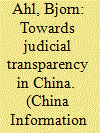| Srl | Item |
| 1 |
ID:
186725


|
|
|
|
|
| Summary/Abstract |
The mass publicity of court decisions in China, this article argues, is part of the larger trend of the Chinese judiciary becoming increasingly centralized. The transparency reform enables the Supreme People’s Court to control the information reporting process within the judicial hierarchy and rein in local courts through public scrutiny. Interestingly, local courts responded strategically, making disclosure far poorer than required. Meanwhile, the central government has dispatched more cadres to local courts, and these cadres are associated with more than a 10 percent higher disclosure rate of judicial decisions, suggesting that centralization of personnel is adopted to effectively implement the centralized policy. The transparency reform, coinciding with reforms in other domains, embodies an important shift toward a more centralized judicial sector in China.
|
|
|
|
|
|
|
|
|
|
|
|
|
|
|
|
| 2 |
ID:
112379


|
|
|
|
|
| Publication |
2012.
|
| Summary/Abstract |
This article focuses on the understudied area of Internet-facilitated judicial transparency and its implications for the right to know, the citizen's engagement with China's court system, and the related development of competent legal reasoning. The analytical focus is on recent China Supreme People's Court regulations bolstering open reporting on court websites. This article explores the scope and quality of this reform, comparing it with earlier 'open trial' initiatives and investigating its origins and its contemporary implications, both in terms of generating public confidence in fair trial and furthering the development of legal education inside and outside of the legal system. The Internet may help to circulate an improved legal reasoning within the judiciary as well as support a more informed public understanding of the law's requirements. Openness may pressure judges into a wider process of research and learning as they are more exposed to public scrutiny. At the same time it may well expose the extant level of legal incompetence in China's new legal system.
|
|
|
|
|
|
|
|
|
|
|
|
|
|
|
|
| 3 |
ID:
158260


|
|
|
|
|
| Summary/Abstract |
Since 2013 judicial reforms in China have intensified. While recent studies of the Chinese judiciary have focused on structural reforms concerning the jurisdiction of courts and internal court management, it has largely gone unnoticed that the Supreme People’s Court (SPC) has established an open-access database archiving the decisions of every court in China. On the basis of legal documents, secondary literature and interviews with experts, this study investigates the implications of the new database. We find that the database establishes new channels of communication that affect the relationship between the courts and the public, and the position of judges within the judiciary. Further, the open-access database facilitates changes in the structure of communication among legal experts, which in turn promotes legal professionalism. We argue that the SPC made use of the party policy on the direct accountability of the courts towards the people in order to pursue its institutional interest in a professional judiciary.
|
|
|
|
|
|
|
|
|
|
|
|
|
|
|
|